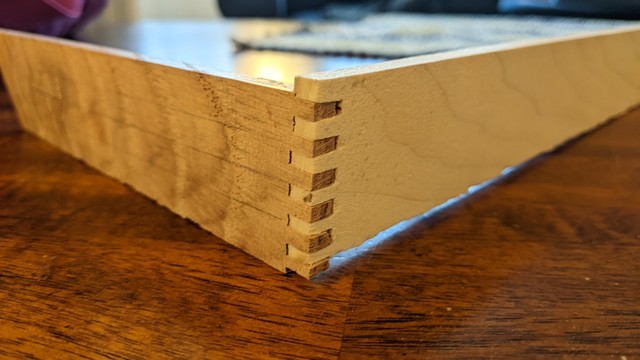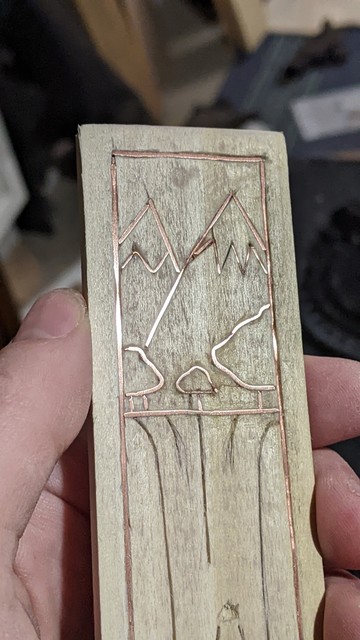Recent searches
Search options
I fell off the wagon... or am I back on my BS?
Either way, I'm making another #chess board.
I took the oak and the poplar, and sanded them both with 120, 150, and 220 sand paper). Then I applied conditioner to the oak, and then stained it with a water based "espresso" stain.
I think the contrast between the white and the black wood is obvious and the wood grain looks great.
I took the board to my table saw and cut it up. Laid in a checker pattern, the pieces fit pretty cleanly together.
One difference between working with 1/4" boards, as I am here, and 1/2" board as I did in the past, is that the glue doesn't feel very strong. Maybe I should give it a backing...
Next, thinking about the sides of the box.
There is nothing like gluing together a bunch of finely cut squares together to demonstrate they are not, in fact, squares, but a collection of 1mm-off irregular rectangles.
It never ceases to amaze me how round saw blades can make such straight, regular shapes. Geometry!
I don't have a lathe, but I do have a table saw, so I'm starting to experiment with ideas for #chess pieces.
These are made out of a 1" ash dowel.
learning a bit more about wire inlay. The idea is that I'll have inlay around the board.
superglue helps!
Pawn and Bishop experiments. I'm growing more and more excited that I'll be able to make something interesting!
I think I need a simpler joint. Tried making a jig, it ended up being too complicated.
OK, starting to make more standardized pieces. I took a pawn experiment I liked and measured the dimensions. Now I'm recreating the pieces.
One challenge: I can't figure out the exact height of the saw blade, so I'm measuring by 1/3rd cranks on the elevation wheel. The base is 0 cranks (no cut), the neck is 5/6, 4/6, and 3/6 cranks, and the "head" is 1/6 cranks.
Boards and margins finished. Having a table saw makes for better joints.
Margins finished (again) for my chess board. I made them in poplar because I think the carving work I want to do will be easier in soft wood.
Then, I cut the 2" sides of the box into 1" slices. Added bevels.
I am stretching my knowledge here, for sure.
For a hot minute I thought I'd decorate the margins with an illustrative scene with wire inlay! Big ambitions to do a series of #LordOfTheRings illustrations with copper inlay.
I've landed on much a simpler geometric pattern. More doable.
Drew the inlay pattern on the opposide side of the board (this time using the speed square... yay for having those right angles handy).
You know, woodworking has made me appreciate the real-world implications of my high school #geometry class.
There's something to be said for proofs - if you have a shape, and you know the dimensions of some of those shapes, you can also know the angles of the shape, and the dimensions of other sides.
I've come to realize the consequences of a decision I made to make the storage space of the board ~1.5" tall (half the dimensions of my first board)!
ALL the pieces (which will be at max 1" wide) must fit on a single side of the box.
I have a plan. It may or may not involve magnets.
Omg. On the *last* element of my wire inlay project I figured out how to do inlay correctly. Look at the difference!
Moving forward (if I do more inlay) I'm going to save so much glue, prevent so much damage to the wood!
Cue the sad trumpets. Major bummer.
I honestly have no idea why this is happening. Did I over sand the wood close up all the pores?
After a 6-months hiatus... once more into the breach, dear friends!
I followed the advice of folks here (thanks all!) and switched up my glue. I used fish glue, which is water soluable. I switched to oak so I'm using a hardwood.
With practice, I'm also getting better at leaving more wire exposed above the wood during the inlay process. This means that theres more wire to sand, and expand with the sanding.
@derek Did you sand after or before the inlay was in?
At a guess, if you sanded after the inlay, particles from the wire became embedded in the wood around the wire, leading to the wood having different properties there, with the metal particles rejecting the stain.
@katanova I sanded after the inlay! And yeah, it looked like there was part of the metal coming into the wood.
Absolutely wild. maybe I should take a page out of this video https://youtu.be/hGrviqJK3Dc?t=1013
@derek have you tried peanut oil (it might not be the right oil but it's one I have used for other wood restoration but I have not done inlay so maybe research that idea & confirm it could help FIRST...
So, you soak the damaged area in an oil that the wood fibers will soak up. It may take several applications to "rehydrate" the fibers. Typically the colour returns... some people use an oil impregnated wax that is liquid at room temperature like Max Wax... but I'm not sure what's in Max Wax & something might react with the copper... straight vegetable oil won't
@derek I wonder if the stain is reacting with the copper?
@derek Others seem more knowledgeable about inlaying, but my first instinct was that whatever glue you used to hold the copper in had absorbed into the wood, preventing the stain from absorbing. What kind of glue did you use? Was there a ton of squeeze out?
@derek Yeah. It looks like whatever this glue is (epoxy?) has sealed the wood. If the copper is deep enough that you can't sand through it accidentally, I'd just sand a whole lot more.
You might be able to test that the wood is absorbent enough by rubbing some mineral spirits on it and seeing if it soaks in evenly.
@derek if you want an off the shelf solution for what @davepolaschek is describing, gel stain is another option. It is a film and doesn't rely on penetrating the wood. So you can still get an even color, even if the wood isn't uniformly absorbent.
Excellent work :D






























